Elpida Hadzi-Vasileva interview: Material Splendor (2014)
artdesigncafé - art | 16 September 2014
This interview was previously published in April 2014 in Sculpture, 33(3), 32-7.
-
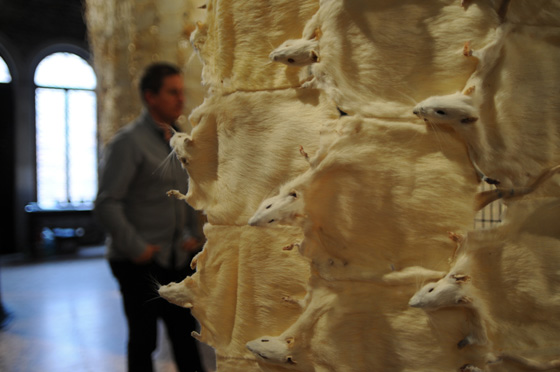
Elpida Hadzi-Vasileva. Silentio Pathologia (installation detail), (2013). Installed at Scuola dei Laneri, Republic of Macedonia Pavilion, 55th International Art Exhibition, La Biennale di Venezia. Photo: Elpida Hadzi-Vasileva. © the artist. Courtesy: the artist and theartistsagency.
Finding rats in the gallery is not usually cause for celebration at an art opening, but such was the case for Elpida Hadzi-Vasileva’s installation Silentio pathologia (2013) at the Macedonian Pavilion of the Venice Biennale. Hadzi-Vasileva has been pushing the boundaries of unusual art “materials” for some time, using salmon and chicken skins, silk worm cocoons, upside-down trees, as well as pig and cow stomachs. Her exploration of what she calls the hidden, the rejected, and the thrown-away contrasts, or integrates, with equally unusual sites, including Gloucester Cathedral, Berwick Gymnasium, and New Forest in the United Kingdom. The result is a range of magical, disturbing, and richly layered works with an aesthetic resonance. Hadzi-Vasileva’s background— she moved to the U.K. from Macedonia at the age of 15— forms an important contextual grounding for her work.
[The following are excerpts of my conversation with Elpida Hadzi-Vasileva.]
R.J. Preece: Your works are very beautiful and richly layered, but also a bit disturbing considering the materials. How do you do it?
Elpida Hadzi-Vasileva: My works are very site-specific, and I draw from hidden, rejected, or thrown-away materials. I spend a lot of time researching a place, its history, environment, and people. The materials are very much driven by the place.
-
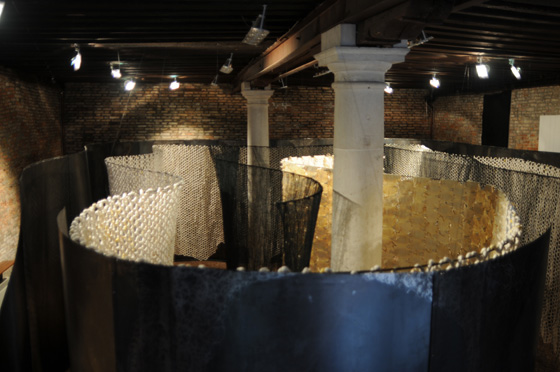
Elpida Hadzi-Vasileva. Silentio Pathologia (installation view), (2013). Installed at Scuola dei Laneri, Republic of Macedonia Pavilion, 55th International Art Exhibition, La Biennale di Venezia. Steel, silk, silk worm cocoons, rat skins, live rats, bespoke cages, cotton and wire; 1600 cm x 1000 cm x 300 cm. Photo: Elpida Hadzi-Vasileva. © the artist. Courtesy: the artist and theartistsagency.
For example, with Silentio pathologia, the material came through my research. I was looking historically at Venice and the plague, how it moved from East to West. I was looking at the Silk Route and other related trading routes, the animals, the rats— they transferred the disease, or it’s believed that they did. That was my starting point, which led to silk, skin, the effect on the body, the plague, and then the rats. The next step was researching the location.
If you are looking at my work from a particular angle, it does appear very beautiful. But when you start looking deeper and start thinking about the materials, there are lots of different layers.
-
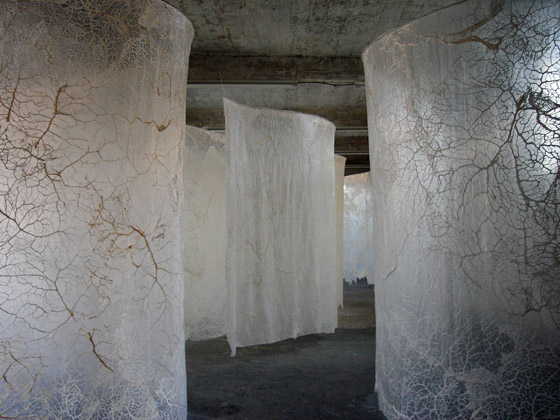
Elpida Hadzi-Vasileva. Butterflies in the Stomach (installation view), (2008). Venue: L’H du Siège, Valenciennes, France. Preserved caul fat, plastic; 2500 cm x 1000 cm x 400 cm. Photo: Elpida Hadzi-Vasileva. © the artist. Courtesy: the artist and theartistsagency.
R.J. Preece: I’d like to walk through some of the works— the materials, forms, subjects, [content] and contexts. First, Butterflies in the stomach (2008).
Elpida Hadzi-Vasileva: The entire installation is made from caul fat, the lining of a pig’s stomach, dried onto very fine plastic. When you touch it, you can make an imprint of your finger on it. It has been preserved and treated in a very traditional way and dried naturally. It has a slight smell of freshly cooked sausages. The material is used in certain cultures and rejected in others.
The form is inspired by looking at the stomach itself, the layers of the intestine, and how we process food through our system. There’s one entrance and one exit. Sometimes the work is very close to the viewer, sometimes it actually touches the body. Human sounds, like the rumblings of an empty stomach or gurgles, accompany the piece.
Butterflies was inspired by working in northern France, in Valenciennes, which is famous for its lace-making tradition, and I was also inspired by French cuisine. The caul fat reminded me of lace, and I wanted to make a visceral space that you enter and where you experience the beauty of the material through movement in close proximity to the body. I wanted the viewer to be immersed in the work.
-
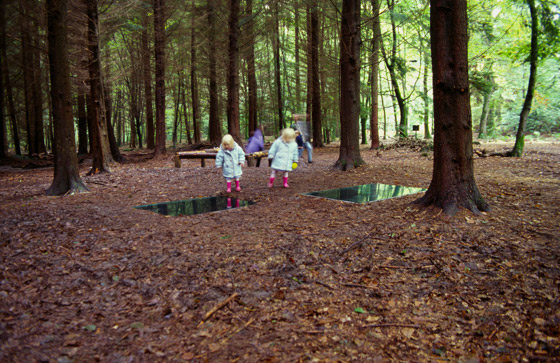
Elpida Hadzi-Vasileva. Ambush (exterior installation view), (2000). Venue: The Rhinefield Ornamental Drive, The New Forest, England. Sculptural excavation (walkable underground space which exposes tree roots) and installation, wood, metal, glass; 2700 cm x 1500 cm x 280 cm. Photo: Elpida Hadzi-Vasileva. © the artist. Courtesy: the artist and theartistsagency.
R.J. Preece: Why do you describe Ambush (2000) as a “sculptural excavation?”
Elpida Hadzi-Vasileva: In the case of Ambush, viewers descend into the ground, rather than walk around a three-dimensional sculpture. It’s the space around the object that defines it, or in this case, the object is the space excavated in the earth, which allows the visitor to view trees from below, looking up through glass windows.
-
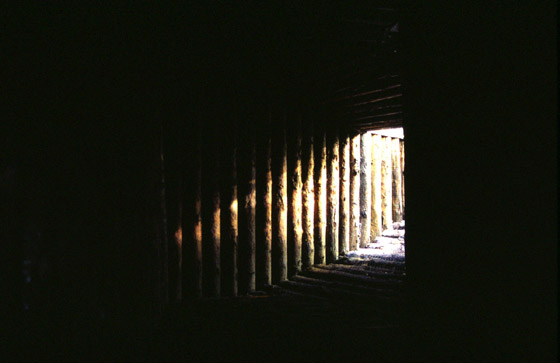
Elpida Hadzi-Vasileva. Ambush (interior view, underground), (2000). Venue: The Rhinefield Ornamental Drive, The New Forest, England. Sculptural excavation (walkable underground space which exposes tree roots) and installation, wood, metal, glass; 2700 cm x 1500 cm x 280 cm. Photo: Elpida Hadzi-Vasileva. © the artist. Courtesy: the artist and theartistsagency.
The work was excavated in the New Forest, one of Henry VIII’s hunting places and now a national park. It shows my interest in places that are beneath or hidden. An extended version was short-listed for the Jerwood Sculpture Prize in 2001, and I envision seeing it as a permanent structure one day.
-
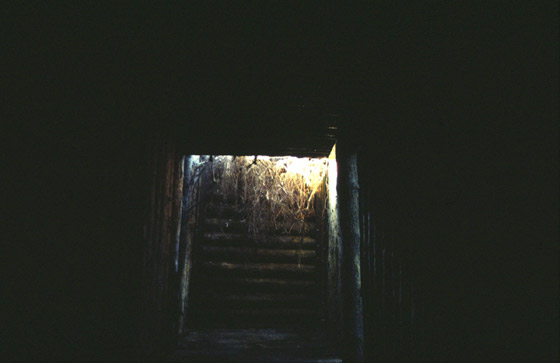
Elpida Hadzi-Vasileva. Ambush (interior view, underground), (2000). Venue: The Rhinefield Ornamental Drive, The New Forest, England. Sculptural excavation (walkable underground space which exposes tree roots) and installation, wood, metal, glass; 2700 cm x 1500 cm x 280 cm. Photo: Elpida Hadzi-Vasileva. © the artist. Courtesy: the artist and theartistsagency.
-
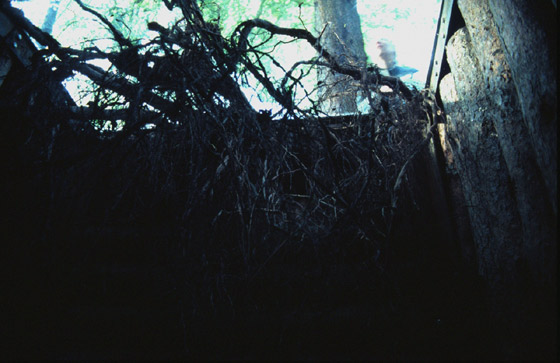
Elpida Hadzi-Vasileva. Ambush (interior view, underground), (2000). Venue: The Rhinefield Ornamental Drive, The New Forest, England. Sculptural excavation (walkable underground space which exposes tree roots) and installation, wood, metal, glass; 2700 cm x 1500 cm x 280 cm. Photo: Elpida Hadzi-Vasileva. © the artist. Courtesy: the artist and theartistsagency.
R.J. Preece: Could you explain how the forms that you created in Epidermis (2000) relate to its site, the Berwick Gymnasium?
Elpida Hadzi-Vasileva: There were four semi-circular, carpet-like forms, one full circle, and two large end structures. The shapes were informed by the colored markings on the gymnasium floor— circles, lines, and ellipses that mark out various games. The work explored the relationship between two important local industries: the armed forces and fishing. It was inspired by the gymnasium, a 1901 listed building, which had been used by the army. Also, the River Tweed, which is famous for its salmon, is nearby. I united the industries through the formal process of transforming existing lines on the gymnasium floor into physical objects. These sculptural elements were created out of salmon skin and bone and then suspended from the ceiling. The skins rotate in the circular forms— with no beginning or end— like the endless return of the salmon to their breeding grounds.
-
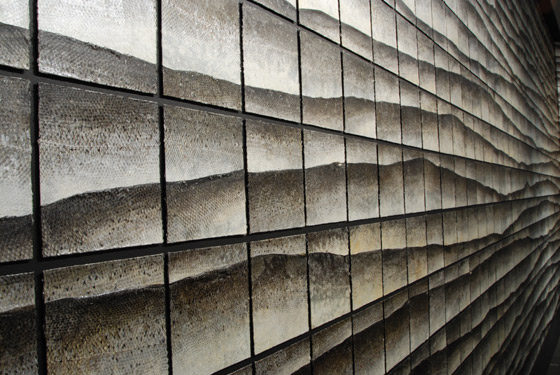
Elpida Hadzi-Vasileva. Reoccurring Undulation (installation view), (2011). Towner, The Contemporary Art Museum, Eastbourne, England. Preserved salmon skins on zinc-plated tiles; 960 tiles of 20 cm x 20 cm. Photo: Elpida Hadzi-Vasileva. © the artist. Courtesy: the artist and theartistsagency.
R.J. Preece: How did Reoccurring undulation (2011) work?
Elpida Hadzi-Vasileva: I wanted to create a work inspired by the white cliffs of Eastbourne, that looked like a landscape drawing from a distance. But when you came closer, you realized what the work was made of. It referenced the traditional fishing industry off the south coast of England, though I used farm-raised salmon. I was looking at how the salmon were bred and produced, with every skin being almost the same size and weight, and I wanted the feeling of a heartbeat. From a distance, it kind of looks like a heart movement, and you could almost hear the animals breathing.
Interestingly, people sensed that there was a smell and came up close to sniff it.
R.J. Preece: Could you tell me about Resuscitare (2013) on the grounds of Mottisfont Abbey in Hampshire, England?
Elpida Hadzi-Vasileva: I worked with a forester who had 35 years of experience in that part of the woodlands. In the 1960s, 34 beech trees were planted in a circle— he was involved in that— and I wanted to engage with this circle. It’s slightly off site, and not many people visit it, but I fell in love with its beauty.
Together, the forester and I selected five oak trees that had fallen almost 30 years ago, and we replanted them upside down, making a hexagonal shape. I also worked with a conservation team and volunteers, who researched Rex Whistler’s original designs for painting the salon with illusionistic Gothic architecture (1938–39).
We then transferred the patterns onto the trees. We hand-gilded the upside-down trees with 23.5-carat gold leaf, which will last a long time, and the trees in the beech circle are gilded with Dutch metal, which has a temporary life span. Resuscitare aimed to link past and present by appropriating the Whistler motifs and placing them on the trees of the old and new circles. So, while offering dead trees a new role as sculpture, I’m also paying homage to previous artistic interventions at the site.
R.J. Preece: How would you describe Bad hair day (2008) in terms of materials, form, content [and contexts]?
Elpida Hadzi-Vasileva: Bad hair day was influenced by Butterflies in the stomach. I was asked by sculptor Tony Hayward to contribute a work to an exhibition called “Heft” at the Winchester Discovery Centre in England (2010), which considered the significance of weight, density, and tactile qualities of visual objects.
I wanted to make a beautiful object from an unlikely material and chose the omasum, the third chamber in a ruminant’s stomach. These were knitted together and stretched from ceiling to floor. So, instead of the sheets of caul fat as in the previous work, here a sculptural form was suspended, located without a plinth, at eye level.
R.J. Preece: What particular challenges and rewards have you encountered while working with animal material?
Elpida Hadzi-Vasileva: There are lots of challenges, and there is such labor-intensiveness to the works. I go through stages in which I spend very long hours with a particular material.
Things happen, and I either dislike using a particular material or I get softened up using it. Or my body reacts to using a particular material.
It’s rewarding when I see people’s responses to my work. I also find it very rewarding to turn a rejected material into something different with a different meaning— almost like elevating something that has been thrown away or rejected.
R.J. Preece: You’ve mentioned your Macedonian background as an influence.
Elpida Hadzi-Vasileva: A lot of my work starts with where I come from. I’m always interested in looking at hidden elements, hidden nature. When I was a child, I used to play in woodlands and mines, and I was always interested in uncovering things. Ambush is perhaps influenced by the extensive mining operations that used to take place in and around Kavadarci, my birthplace in Macedonia.
In the case of Silentio pathologia, which was influenced by its location in Venice, I also wanted to make reference to Macedonia, which is an agricultural country with a very long history of textile production. My hand work, which is very much engrained in me, comes from Macedonia and uses traditional skills.
There’s a saying, something like “where you come from, you can never forget.” I think there’s something inside of me, that no matter what, where I come from will always come to the surface.
R.J. Preece: You’ve collaborated with engineers, architects, arborists, scientists, chefs, doctors, fishermen, miners, taxidermists, and factory producers. Who has had the greatest impact on your work?
Elpida Hadzi-Vasileva: It’s difficult to say. They’ve all influenced my work at different stages in my career. And their expertise has been really valuable in making the work successful, I think. My collaboration with a taxidermist has influenced my work for a few years now, in pieces such as Epidermis, Butterflies, Bad hair day, Silentio pathologia, and the chicken skin dress in Motectum. I’m very interested in preservation, conserving materials.
R.J. Preece: You’ve worked on projects at various heritage sites, including Gloucester Cathedral and the New Forest. How do these spaces differ from art spaces?
Elpida Hadzi-Vasileva: I’ve worked with both, but more with heritage and “outside” sites. In most cases, I work with an art professional, like a curator, involved in the project. It’s obviously a very different way of working than in a white-cube space, in terms of scale, light, floor.
R.J. Preece: How permanent are these works?
Elpida Hadzi-Vasileva: Some are more permanent than others. Butterflies has been preserved and can last a long time. Reoccurring undulation and Silentio pathologia are both permanent pieces.
Permanency intrigues me. I always ask: What is permanent? Nothing is permanent to me; everything has a life span.